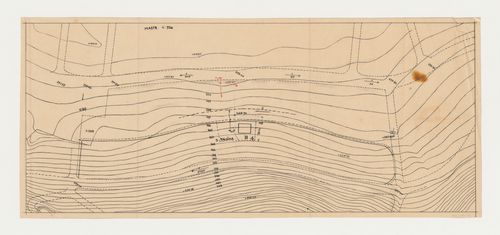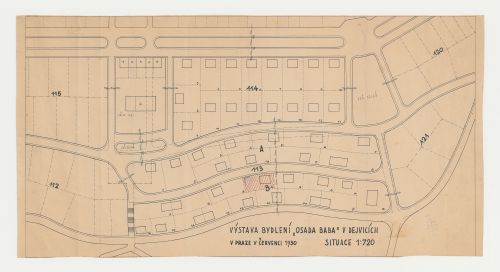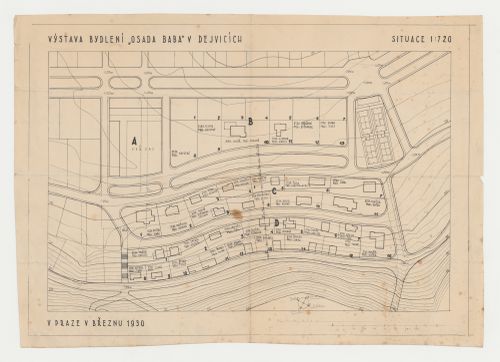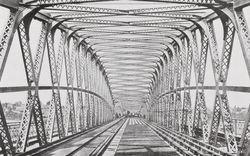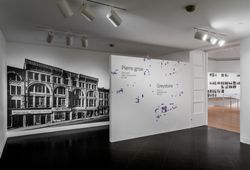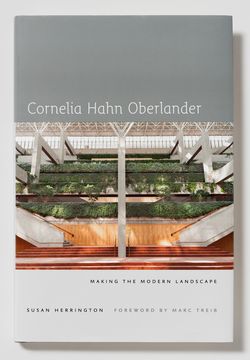DR1984:1338
Description:
- A dotted line in pen and black ink on the topographic survey indicates the lot for Villa Palicka.
architecture, topographic, urban planning
1928-1932
Topographic survey for Baba Villa Colony showing the lot for Villa Palicka, Prague, Czechoslovakia (now Czech Republic)
Actions:
DR1984:1338
Description:
- A dotted line in pen and black ink on the topographic survey indicates the lot for Villa Palicka.
architecture, topographic, urban planning
DR1984:1340
Description:
- Hatching in red ink with blue pencil on the site plan indicates the lot for Villa Palicka.
architecture, urban planning
printed June 1930
Site plan for Baba Villa Colony showing the lot for Villa Palicka, Prague, Czechoslovakia (now Czech Republic)
Actions:
DR1984:1340
Description:
- Hatching in red ink with blue pencil on the site plan indicates the lot for Villa Palicka.
architecture, urban planning
DR1984:1341
Description:
- Lot numbers and the names of the architects and clients are inscribed on this site plan for Baba Villa Colony, Prague, Czechoslovakia (now Czech Republic) (see object file DR1984:1338 - 1366 for a table by J. Viloria listing lot numbers and the names of the architects and clients).
architecture, urban planning
printed March 1930
Site plan for Baba Villa Colony, Prague, Czechoslovakia (now Czech Republic)
Actions:
DR1984:1341
Description:
- Lot numbers and the names of the architects and clients are inscribed on this site plan for Baba Villa Colony, Prague, Czechoslovakia (now Czech Republic) (see object file DR1984:1338 - 1366 for a table by J. Viloria listing lot numbers and the names of the architects and clients).
architecture, urban planning
textual records, photographs
Quantity:
7 file(s)
DR1988:0016:001-007
Description:
Part of a miscellaneous group of visual and textual documents collected by Oswald Mathais Ungers, apparently to represent the work of artists/architects in Die gläserne Kette. Consists of memorabelia of Paul Goesch, including 6 photographs and a diploma.
1911
Material from Paul Goesch mostly for Die gläserne Kette
Actions:
DR1988:0016:001-007
Description:
Part of a miscellaneous group of visual and textual documents collected by Oswald Mathais Ungers, apparently to represent the work of artists/architects in Die gläserne Kette. Consists of memorabelia of Paul Goesch, including 6 photographs and a diploma.
textual records, photographs
Quantity:
7 file(s)
1911
articles
Lexical Holes
20th century, A W-Hole House, Boston Road Floor Hole, Bronx Floors, Datum Cut, film, Frances Richard, Gordon Matta-Clark, photographie, photography, Quadrille, Rooftop Atrium, Splitting, Threshole, XXe siècle
12 December 2019
archives
Level of archival description:
Fonds
Joseph Rykwert fonds
AP209
Synopsis:
The Joseph Rykwert fonds, 1928-2022, documents Joseph Rykwert’s career as an architectural historian, author and professor. The fonds includes the records for over a dozen monographs written between the mid-1960s and the mid-2010s as well as edited works and articles, and details his teaching and lecturing activities from the 1960s onwards in universities in Europe and the United States. The records highlight Joseph Rykwert’s multidisciplinary approach, which involved archaeology, anthropology and psychoanalysis in his study of the history and theory of architecture and of the urban form. The fonds is composed of textual records, publications and ephemera, and of photographs including multiple albums and a large number of slides; the fonds also documents Joseph Rykwert’s career as an independent designer through drawings realized between the late 1940s and the late 1970s.
1928-2022
Joseph Rykwert fonds
Actions:
AP209
Synopsis:
The Joseph Rykwert fonds, 1928-2022, documents Joseph Rykwert’s career as an architectural historian, author and professor. The fonds includes the records for over a dozen monographs written between the mid-1960s and the mid-2010s as well as edited works and articles, and details his teaching and lecturing activities from the 1960s onwards in universities in Europe and the United States. The records highlight Joseph Rykwert’s multidisciplinary approach, which involved archaeology, anthropology and psychoanalysis in his study of the history and theory of architecture and of the urban form. The fonds is composed of textual records, publications and ephemera, and of photographs including multiple albums and a large number of slides; the fonds also documents Joseph Rykwert’s career as an independent designer through drawings realized between the late 1940s and the late 1970s.
archives
Level of archival description:
Fonds
1928-2022
archives
Level of archival description:
Fonds
Peter Eisenman fonds
AP143
Synopsis:
The Peter Eisenman fonds documents Eisenman's professional activities as an architect, teacher, and author from the 1950s to 2008. More than 200 projects are represented through conceptual and design development drawings, models, photographs, textual records, and computer-aided drawings. Also well represented in the fonds are materials related to Eisenman's exhibitions, publications, and writings.
1925-2008, predominant 1951-2008
Peter Eisenman fonds
Actions:
AP143
Synopsis:
The Peter Eisenman fonds documents Eisenman's professional activities as an architect, teacher, and author from the 1950s to 2008. More than 200 projects are represented through conceptual and design development drawings, models, photographs, textual records, and computer-aided drawings. Also well represented in the fonds are materials related to Eisenman's exhibitions, publications, and writings.
archives
Level of archival description:
Fonds
1925-2008, predominant 1951-2008
articles
20th century, Alfred Gotthold Meyer, Allemagne, Deutscher Werkbund, engineering, Friedrich Naumann, Germany, ingénierie, Ingenieur-Ästhetik, Joseph August Lux, Karl Marx, Katherine Romba, Munich, Rudolf Metzger, William Morris, XXe siècle
14 October 2010
The greystone buildings standing in Montreal today are essential tools for understanding the city. A deep study of their material history from the late 17th century to the early 20th demonstrates how geology, topography, politics, ethnicity, culture, as well as changes in economy and technology, have shaped the city through the centuries. Conceived as a photographic(...)
Octagonal gallery Keyword(s):
Greystone, Phyllis Lambert, Montréal, photography, Richard Pare
13 October 2017 to 4 March 2018
Greystone: Tools for Understanding the City
Actions:
Description:
The greystone buildings standing in Montreal today are essential tools for understanding the city. A deep study of their material history from the late 17th century to the early 20th demonstrates how geology, topography, politics, ethnicity, culture, as well as changes in economy and technology, have shaped the city through the centuries. Conceived as a photographic(...)
Octagonal gallery Keyword(s):
Greystone, Phyllis Lambert, Montréal, photography, Richard Pare
The first biography of one of the most influential landscape architects of the 20th century, Cornelia Hahn Oberlander: Making the Modern Landscape draws upon archival research, site analyses, and numerous interviews with Cornelia Oberlander and her collaborators. Author Susan Herrington joins Oberlander in conversation about her works and career. The series They want(...)
14 September 2014 , 3pm
Cornelia Oberlander and Susan Herrington want to speak with you
Actions:
Description:
The first biography of one of the most influential landscape architects of the 20th century, Cornelia Hahn Oberlander: Making the Modern Landscape draws upon archival research, site analyses, and numerous interviews with Cornelia Oberlander and her collaborators. Author Susan Herrington joins Oberlander in conversation about her works and career. The series They want(...)
